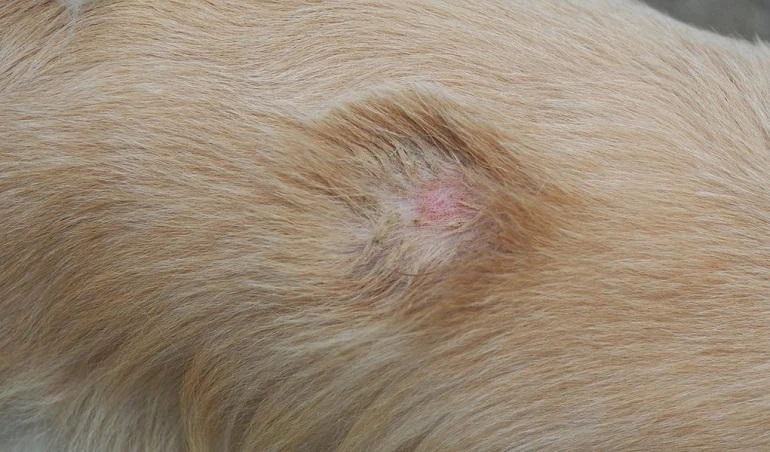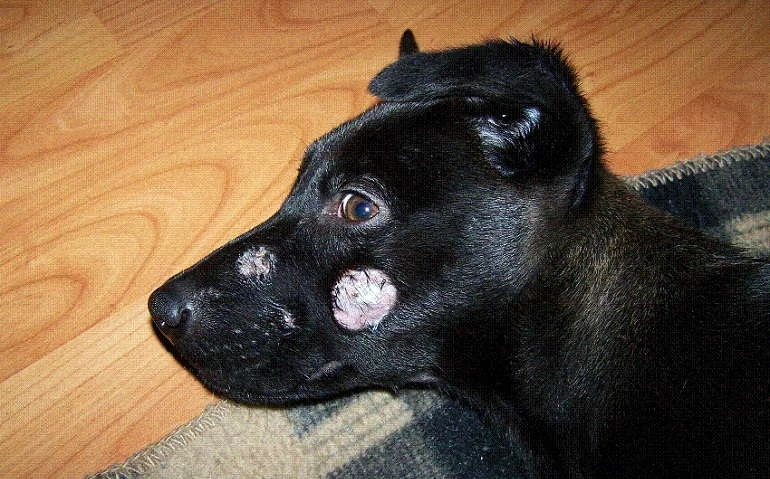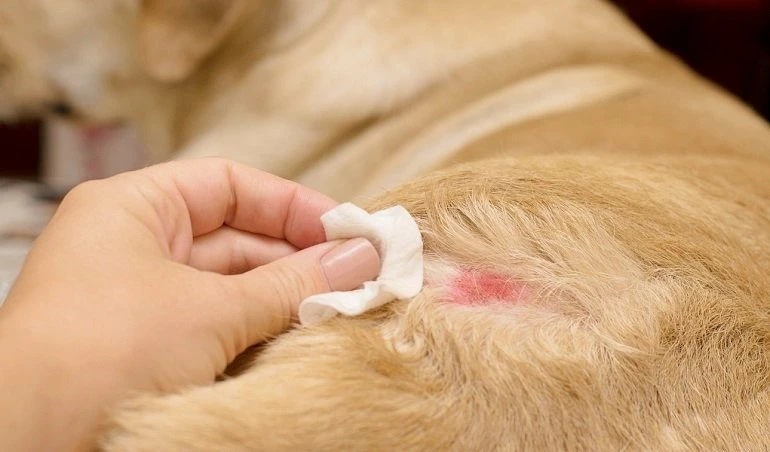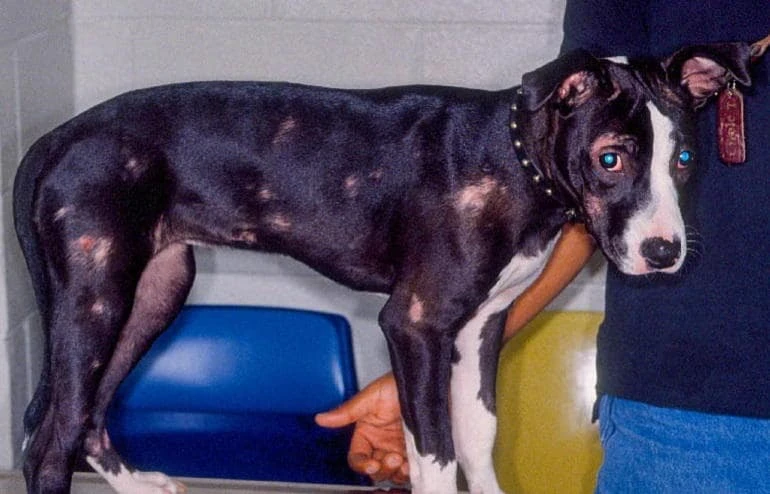Ringworm in Dogs: Symptoms, Causes and Treatment
by Patricia Jackson
With the many parasite types that afflict dogs out there, from tapeworms to hookworms, it is easy for pet parents to categorize ringworms as part of them. However, ringworm is an entirely different problem that can affect your dog, and they are actually not worms like the others.
Given how common ringworms are, every pet parent needs to understand what they are, their causes and symptoms and how to deal with the problem.
What is Ringworm?

Ringworm is the common name for dermatophytosis, a fungus that infects a dog's skin, nails or hair. This fungus infection is typically just superficial and not life-threatening, but it is highly contagious and one of the few diseases that can be passed from dogs to humans or vice versa.
The ringworm fungus finds habitat in the outer layer of the pup's skin and hair follicles. On some rare occasions, you can see this fungus infecting the nails. For dogs with compromised immunities, puppies and senior ones, the ringworm infection can sometimes be more widespread.
Symptoms of Ringworm in Dogs

For some dogs, it is hard to tell when they have ringworms as they can be asymptomatic, meaning they show no symptoms but still spread the disease. However, the following are the most common symptoms of infestation.
- Round, Irregular Markings: This is perhaps the most common symptom of ringworms, and these markings are often also raised.
- Hair Loss: The hair weakens in areas with the ringworms, and so it breaks off easily, leaving the pet with a patchy coat.
- Crusting or Darkening of Skin: Since the ringworm fungus is a foreign element growing on the pet's skin, it can darken or crust the skin.
- Raised Nodular Lesion: These are often referred to as Kerion, and although this is a rare symptom, for severe cases, oozing nodular lesion can be a symptom.
- Rough and Brittle Claws: When the fungus infects the claws, they get coarse and brittle. Sometimes they also malformed, and you can see some inflammation around them.
Causes of Ringworm
According to the American Kennel Club, about 70% of ringworm infections in dogs are caused by a fungus known as Microsporum canis, 20% of the remaining cases result from Microsporum gypseum, while the other 10% come from Trichophyton mentagrophytes.
Most dogs get ringworms by coming in contact with other infected animals or people. When the canine touches or licks an infected object such as brush, comb, bowl or carpet, it is highly likely to get infected. The worst part is that the fungal spores that lead to the spread of ringworms remain viable in the contaminated surfaces for more than 18 months.
Treatment of Ringworm in Dogs

Once the vets diagnose your pet has ringworms, they can recommend one of the following or a combination of two or all of them to treat the condition.
1. Topical Therapy
Most vets tend to recommend topical therapy, which entails giving or prescribing an ointment, cream or shampoos to apply directly in the pet's skin. The vet also endorses trimming the pet's fur to speed up the results. However, topical therapy is still quite a slow treatment method.
2. Oral Medications
For faster and more effective results, many vets recommend oral medication to go with topical therapy. Here anti-fungal medication is the standard treatment, and dogs have to take it for at least one and a half months.
3. Environmental Decontamination
Decontaminating the environment in and around your home is an essential part of treating ringworms. Vacuuming furniture and carpets that your dog comes in contact with eliminates contaminated hair and skin.
Note: Ringworms are a self-cure disease, and in many instances, treatment is only meant to speed up the process and minimize the risk of spreading it to other pets or even humans.
Prevention Ringworm in Dogs

- Keep the Home Clean: One of the most effective ways of preventing ringworms is keeping your home and surroundings clean. Regular cleaning ensures you can remove any infected things like hair before they can infect your pup.
- Isolate Pets Undergoing Treatment: If you have other pets in the house that are already infected with ringworm, you need to isolate them to ensure they never come in contact with the dog. Remember, the pet remains contagious even as it undergoes treatment.
- Minimize Petting by Strangers: No matter how adorable your pup might be, you need to be very keen with whom you allow to pet it. Someone with ringworms or has been petting an infected dog can easily pass it to your pup.
- Do Not Allow Dogs to Play in the Dirt: If your dog has an open wound or a skin condition, it is vital to ensure it does not play in the dirt. Also, if other animals frequent the specific playing spot, it is better to avoid it to minimize the risk of getting ringworms.
Can I Get Ringworm from My Dog?
You can get ringworms from dogs, and you can also infect the pet if you already have them. Children, the elderly, and people with a compromised immune system have the highest risk of getting ringworm from dogs. Therefore as you treat a dog with this disease, you need to take enough precaution to minimize your exposure to the fungus.
Conclusion
Ringworms are a common dog disease caused by a fungus. Although it is not life-threatening and is usually self-healing, it is essential always to treat it the soonest possible to ensure it does not spread to other pets or people as it is highly contagious. Treatment typically entails topical therapy and oral medication. However, environmental decontamination can also be very useful for treatment and prevention.
Sources
- Ringworm in Dogs - PetMD
- Ringworm (Dermatophytosis) in Dogs - MSD Veterinary Manual
 |
 |
 |
 |

About Patricia Jackson
Patricia just simply loves pets.
When she was eight years old, her parents got her a beautiful Maine Coon as a gift; and later an affectionate Husky.
Since then, she has raised them as her children; done minor first aid, taken in strays, administered antibiotics, bottle fed them when sick, and even midwifing.
Pat received her bachelor's degree in computer science at Univercity of Califronia Davis. She really hopes to transofrm her programming skills into something that really helpful for all pets someday. For now, lets just do that through writing.
Thoughts on "Ringworm in Dogs: Symptoms, Causes and Treatment"
 |
 |
 |
 |
Pet Care Tips
You can Get FREE Gifts. Furthermore, Free Items here. Disable Ad Blocker to receive them all.
Once done, hit anything below
 |
 |
 |
 |